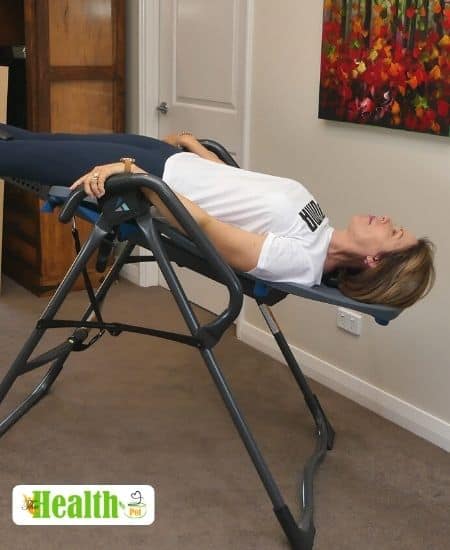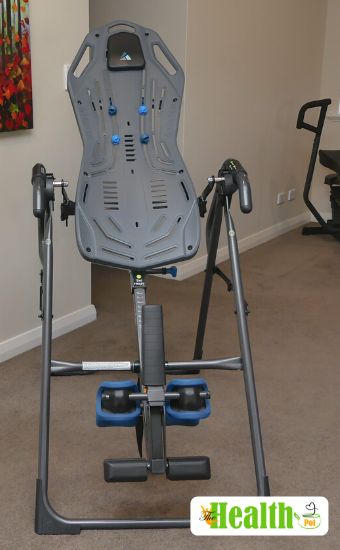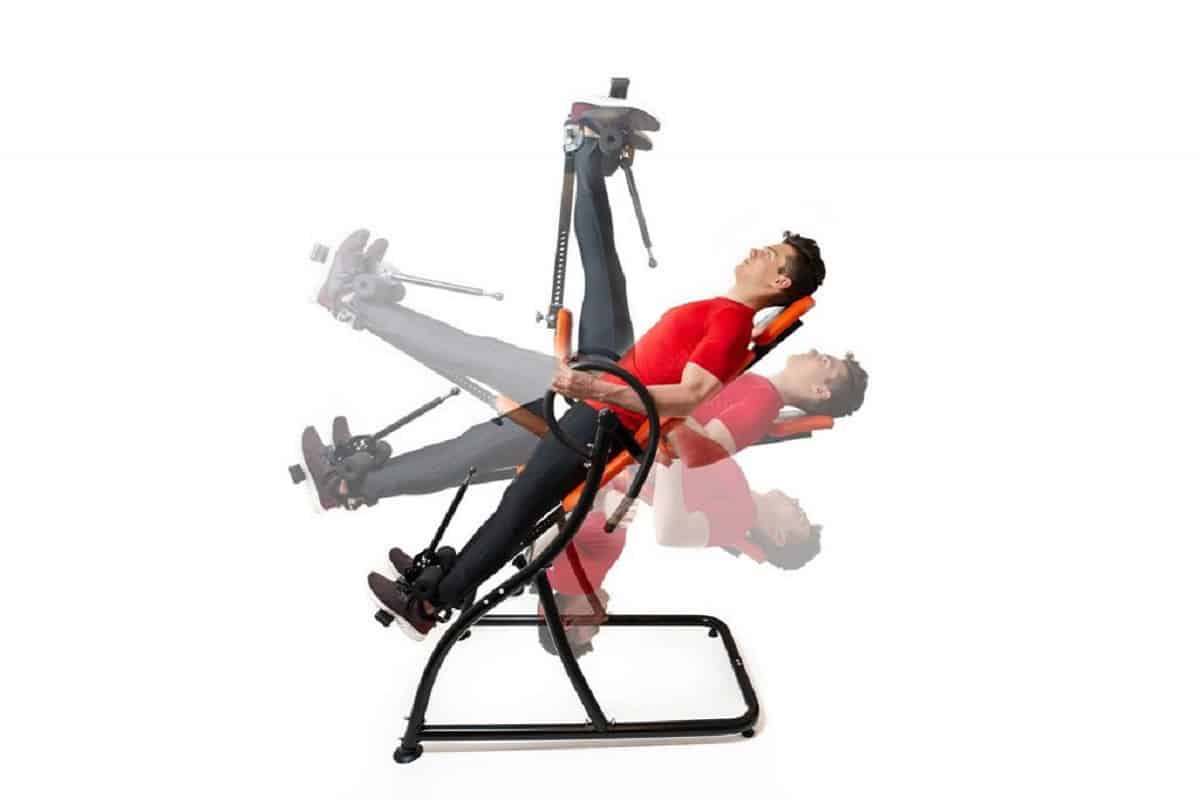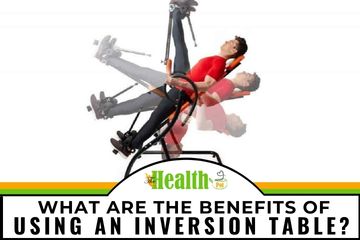For those who suffer from back issues, inversion tables seem like a godsend. They are a non-invasive solution to poor back health, providing passive mechanical traction that decompresses your spine, lowers the stress placed on your body, and improves your spinal health.
With an inversion table, you can assume an inverted position from a range of different angles. All you need to do is lie on a platform with your ankles supported by a bracket that has a ratchet mechanism.
Some inversion tables are capable of total inversion, although people tend not to go past 60 degrees.
These tables use your body weight and gravity to apply traction to the spine and effectively stretch it.
This action widens the space between your spinal vertebrae, relieving pressure on the discs and nerves in your back and improving circulation.
An inversion table can be helpful if you experience neck and back pain and pinched nerves, or if you suffer from degenerative disc disease, herniated disc or slipped disc, sciatica, or spinal stenosis.
Can an inversion table be something we could all make use of in our everyday lives even if we don’t suffer from the abovementioned conditions?
Let’s find that answer to that, but first, we’ll talk about what an inversion table does, and is it worth buying?
The Benefits of Using an Inversion Table

An inversion table can be life-saving for those who have back problems, providing much-needed pain relief, but inversion tables actually offer more than that.
Regardless of age or how fit you are, regularly inverting by using an inversion table can be beneficial for your body in several ways. Here are the top 5 benefits of an inversion table.
Related Post: Click Here to Read My Full Review On the Teeter Inversion Table!
1. Back Pain Relief
We will all experience back pain at some point in our lives, and most of us who are curious about inversion tables are looking for solutions to alleviate back pain.
Inversion tables are a natural and passive alternative to painkillers or surgery for alleviating back pain. This is because of the wonders of decompression, which is a unique form of spine-stretching that uses your body weight and gravity.
You’ll feel relief from pain, thanks to the decompression that your weight-bearing joints get.
2. Relaxing
If you’re feeling stressed, tense, or experiencing shoulder pain, neck pain, or recurring tension headaches, then an inversion table might work for you.
We put our muscles under a lot of stress daily, whether it’s due to sitting down too much, poor posture, or the stresses of everyday life. To compensate for misalignment and poor posture, our muscles will tighten and lead to backache and headaches.
Eventually, muscle tension will affect your mood, which is quite understandable. How can you be in a good mood when you’re suffering from muscle aches? Worse, it can even impact your sleep patterns.
Inverting on an inversion table stretches the muscles supporting your spine, helping your body achieve correct posture. All you need is a few minutes for your body to decompress and your muscles to relax.
3. Great Post Work-Out Stretching
Working out is no doubt crucial to maintaining fitness, but you must never forget how important it is to do post-workout stretching to relax the body, especially after doing weighted exercises like deadlifts and squats.
Stretching for a couple of minutes on an inversion table post-workout helps to stretch your body, decompress your spine, and relax your muscles to reduce soreness.
4. Strengthens Your Core
To properly support your torso, you need strong abdominal muscles, internal and external obliques, and lower back muscles.
When you have a good core, it improves your posture, flexibility, and blood circulation. Doing crunches or sit-ups on an inversion table helps you to define and develop your core muscles.
5. Excellent Start to Your Day
Incorporating an inversion table is a surefire way to wake you up in the morning! The extra oxygen to your brain perks you up just as much as a cup of coffee. Learn more about Is inversion good for the brain, you might be very surprised what you learn!
Plus, if you find yourself rather stiff when you wake up, spending a few minutes on an inversion table can reduce your stiffness and help you achieve good posture.
You don’t need to go crazy or push yourself too far either, just 1-2 minutes on an inversion table at 60 to 70 degrees is all you need.
The Risks of Using an Inversion Table
Now that we know the benefits of using an inversion table, I’ll take you through some of the risks involved.

While inversion tables are usually considered safe, full and even partial inversion can increase the blood flow and pressure to your eyes and head.
For this reason, you should avoid inversion tables if you have any of the following issues:
- ankle problems
- detached retina
- fractures
- glaucoma
- heart disease and other circulation disorders
- hypertension
- joint problems such as anterior cruciate ligament injuries
- osteoporosis
If you are interested in an inversion table, you must first consult with your doctor to make sure that it is safe for you.
How to Choose the Best Inversion Table
Another thing that makes inversion tables so appealing is the fact that they can be so easily used in your own home. Here are the things you should look for in an inversion table for your home:
- Certifications from Trusted Bodies – You should always check whether your inversion table is approved by the Food and Drug Administration (FDA) and is registered. You should also check if the inversion table has been lab-tested for durability.
- Safety Features – If you fall off an inversion table you can seriously hurt yourself, so make sure that it has adequate safety features and is durable.
- Ankle Support System – Most inversion tables will have extra-long handles to keep your ankles secure. Ankle closures that do not fit well can also be painful and cause pinching.

Ankle Support System on My Teeter FitSpine – I have found it to be the best as there is no pain on the ankles - Easy to Use – Look for an inversion table that you can easily control and adjust the angle and rotation.
- Locking Systems – Some inversion tables have pin systems, while some will use straps or tethers to limit the angle of inversion.
- Easy to Set Up – While some tables will come already assembled, some inversion tables will need some assembling, so if you’re buying one, find out if it comes with detailed instructions and videos.
- Easy to Store – If you are limited on space, then you may want to choose a foldable table. You can even buy an inversion table with wheels and a table that comes with a storage bag.
- Additional Features – Some inversion tables will have heat and vibration pads, and some may even come with removable pillows and lumbar cushions.
Final Thoughts
Sitting, standing, and even exercising can put pressure on your spine. Spinal compression can cause back pain, muscle pain, pinched nerves, and spasms, so it’s good to know that you can opt for an inversion table. It’s a non-invasive and safe way to relieve back pain.

However, an inversion table needs to be used safely, and there are some risks attached to it, especially for people who suffer from certain health conditions. You should always consult your doctor before using an inversion table.
FAQs
1. How long should you use an inversion table if you’re a beginner?
If you’re using an inversion table for the first time, then start using the table for 30 seconds to a minute each day. Gradually increase your session every day, but if you ever start to feel uncomfortable, then slowly tip back up.
2. What is the maximum amount of time you should spend on an inversion table?
With regular use you can spend up to 5-10 minutes on an inversion table, or as soon as you start to feel sufficiently relaxed. However, hanging upside down for too long can send too much blood rushing to your head, which is dangerous.
5. How many times a day can you use an inversion table?
There really isn’t a limit on how many times you can use an inversion table in one day. Some people just use their tables once a day, while some will use their tables several times a day.
Written by Kathleen Langdon – TheHealthPot.com Founder
Certified Personal Trainer (CPT), Certified Corrective Exercise Specialist (CES)
Kathleen, a mother of two, struggled with ongoing weight and health issues. She created this website after she turned her life around. She built Thehealthpot.com to help inspire and motivate others with their fitness goals. Read more about Kathleen here.


